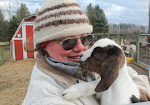 While hand-milking a few goats is no big deal, I knew I'd require a little mechanical help when it came to a dairy animal with an udder the size of New Hampshire. A few years ago, my neighbor had given me an old Babson Surge Milking System, complete with vacuum pump and portable bucket. However, since he had milked his goats, too, with the bucket, the unit had been modified for two teats instead of four. At first, I thought I could get away with just doing the front quarter and then the hind quarter, but after cruising on eBay for a few weeks I came across a really nice unit at a reasonable price.
While hand-milking a few goats is no big deal, I knew I'd require a little mechanical help when it came to a dairy animal with an udder the size of New Hampshire. A few years ago, my neighbor had given me an old Babson Surge Milking System, complete with vacuum pump and portable bucket. However, since he had milked his goats, too, with the bucket, the unit had been modified for two teats instead of four. At first, I thought I could get away with just doing the front quarter and then the hind quarter, but after cruising on eBay for a few weeks I came across a really nice unit at a reasonable price.Another reason I was anxious to get the Surge Milker going was to further alleviate my chances of getting the snot kicked out of me. Trust me, you just don't go and start tweaking teats on a first time freshener without any argument. And goats don't kick no where as hard as cows do.
The first day of trying to milk Emma was frustrating for the both of us. She managed to knock off my glasses with her tail. By the time I was done, I had more milk on my clothing than in the bucket.
The Second Day
Realizing that Melanie, Ralph or Jessica won't always be around to help, I decided to tackle milking single-handedly. Getting a better idea for what's going on, Emma was much more agreeable today. Her calf had been nursing regularly and she knew what that giant thing between her hind legs was for now. Plus, to help reduce the swelling, I was also rubbing her swollen bag regularly with "Udder Comfort", a natural cream that contains Peppermint Oil, Tea Tree Oil, Menthol & Lanolin. I can't believe I paid more for cream to rub on my cow's udder than for something I'd put on my own face!
 Every few hours, I'd go out and milk Emma. She would start off agitated, but when I whipped out the cream, she'd relax. We always ended on a good note, and by the afternoon she would just stand there without even being tied.
Every few hours, I'd go out and milk Emma. She would start off agitated, but when I whipped out the cream, she'd relax. We always ended on a good note, and by the afternoon she would just stand there without even being tied.So by late afternoon, I was ready to fire up the Surge Milker. Everything was cleaned & sanitized. All I would have to do is hook up the regulator to the vacuum compressor, adjust the inflation rate and try to convince Emma that the alien contraption I was about to attach to her udder would not kill her. But when I went to plug in the compressor, I couldn't find the cord. Upon further inspection, I couldn't find the motor! And then it hit me. We had taken the motor off the compressor earlier this summer to use on the hay elevator.
So I'll be hand-milking until I can get to Tractor Supply and get a new motor. We've decided to dam-raise the calf so I really only have to milk out the right quarters since the calf prefers the left side and has been draining them herself.
Freaking Out
Around three-three thirty, the milk turned a strange color. It was watery and brown. Jessica said it looked like iced-coffee. Frantic, I called Melanie who was in Philadelphia with the Pennsylvania Farmstead & Artisan Cheese Alliance visiting White Dog Cafe, Reading Terminal Market and meeting with Jeffrey Roberts, author of Atlas of American Artisan Cheese, at DiBruno Brothers. It was a trip that I was supposed to be on, but with the calf's arrival, I knew there was no way I could swing it.
"Don't worry. It's just capillary bleeding and it's colostrum," she assured me. I'd seen plenty of colostrum, but never anything this dark. Maybe it's true that brown cows give brown milk.
While cleaning out the horse's stall next to the cow's stall, Emma laid down and took a nap, but when it was time to clean out her stall, she refused to get up. Panic-stricken, I called Melanie's mom, Susan, who has been milking for 30 years and is a walking encyclopedia about cows. If Emma wouldn't get up, she suggested calling the vet.
Twenty minutes later, Dr. Trent and his darling daughter arrived. The moment he pulled in, Emma stood up and began eating. "There's nothing wrong with her," he assured me. Her ears were warm, her heart rate and breathing normal. I showed him her milk. "That's colostrum from a Jersey. Don't you know that brown cows give brown milk?" I love my vet. He's got a great sense of humor.






I love new mommy's!
ReplyDelete